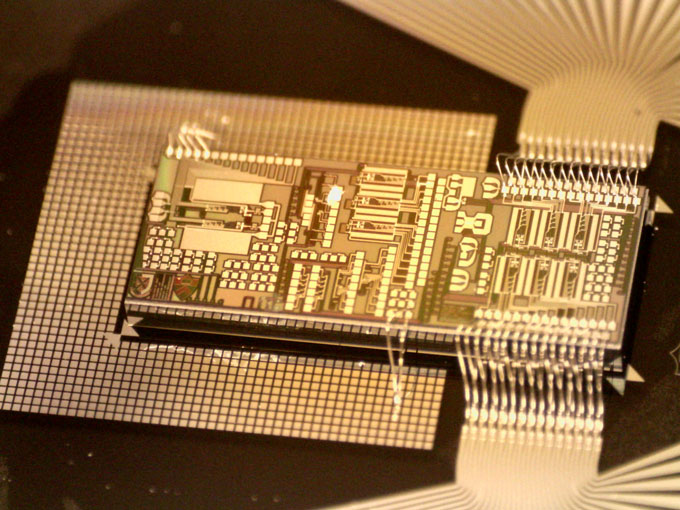Bhavin Shastri still gets excited when he sees a laser pointer and has been fascinated by them since he was about 10 years old. “I was surprised that a ray of light could preserve its brightness, concentrated in a small place even after traveling a great distance,” Shaastri says. “A laser pointer in my hand felt like a lightsaber Star Wars.
Now a physicist and engineer at Queen’s University in Kingston, Canada, Shaastri wants to create light -based computers – or photon. And he wants them to mimic the human brain.
Standard computers rely on electricity, using wires to transmit data via electrical currents. Photonic computers instead rely on light in the form of laser beams. Filters along the way change the intensity of the light to perform the calculations.
Although researchers have used light to transmit, store and process data to the laboratory, the photon computer is still in its infancy. Shaasti has begun to push those boundaries. Its photon chips of the computer pack together and connect the photonic ingredients that behave like brain neurons, creating a physical nerve network in a chip. “Physics imitates biology,” Shaastri says.
These types of chips are more powerful for certain applications and can be a big help for AI.

Modeling computers like the brain
Shaasti’s interest in light began new. He remembers an experiment he saw as a child: a bottle of plastic water was pierced near his base so that a steady flow of water flowed out and down under the force of gravity. A laser shone through the hole in the bottle and, to Shastri’s surprise, it did not continue on a horizontal path. Instead, the beam bent down with the flow of water. “I was completely blown away by this experiment,” he says.
Since then, Shastri has been thinking about how light can be manipulated, while also exploring other research interests. In college, he worked with a professor who was researching machine learning and artificial intelligence, which sparked a new passion. Later, as PostDoK at Princeton University, Shaastri met the optical physicist Paul Prucnal, who would serve as Shasti’s adviser.
Prucnal told Shaastri about his research by creating “a laser that behaves like a biological neuron,” Shaastri says, and how the team was looking to use such a laser to calculate with light. This idea attracted Shasti’s attention.
Shastri was “the first to connect the dots,” Prucnal says, when he realized that photonics could overcome some serious limitations of electronics.
Standard computers are “reaching their fundamental limits,” says Shastri. When most modern computers calculate, they cannot access most of their memory at the same time, and when they are receiving information from memory, they cannot be counted. This makes computers slow and difficult for him, image processing and other calculations with high processing requirements. Training and running today’s algorithms consumes a large amount of energy – collectively, predicted to require as much electricity consumption in Japan by 2026. Computers with architectures that mimic the brain, or neuromorphic computers, promise to be faster and use less energy.
“We want to build cars that will be much more efficient in energy and much faster than other computers,” says Shaastri.
But enough clustering of wires in a chip to form a network of connections like the brain for use on an electronic computer is not easy. Electric currents in the vicinity will exercise unwanted magnetic forces over each other, resulting in overheating and irregular performance. Light, however, usually does not interact with other light. Thus, countless light rays with different wavelengths can cross the same road at the same time without any problems.
Prucnal notes that Shastri was the first to successfully create neuromorphic photonic computers on a chip. “Bhavin pioneered a way of thinking,” he says.
The study of light
A self-described “strong experimentalist”, the shaast designs, engineers, builds and performs experiments on chip-sized photon equipment. His team began by studying simpler devices similar to a single neuron, analyzing how they could imitate the function of a biological neuron. Years later, in a still-published job, researchers have demonstrated in advance that a chip of 100,000 neuronic ingredients can perform 120 billion operations per second, says Shaastri-about 40 times faster than the average electronic computer.
Daniel Brunner, a scholar of teaching and calculating machinery at the Femo-St institute in France who met with Shastri when they were both postdox, praised the initial work of Shaastri. “I can’t even calculate publications where he essentially laid the foundation” for using photonics to create physical nerve networks, says Brunner.
And Shaast’s brilliance goes beyond his “extraordinary energy” and “extraordinary ability”, says Prucnal: Shaasti is able to unite people. “It’s not just about being likable, it’s about having a vision of how to do it [unite] These different areas, ”he adds.
Don’t expect a photonic neuromorphic computer in your home anytime soon, though. These computers are best suited for specific research or industry applications. In addition to him, Shaastri and his colleagues are working in applications that include long problems in radio signal optimization and image processing.
The shaast may be determined in the transformation of computers, but its work is motivated by a decades of fascination with its light and its properties. “I’ve been very lucky to be able to do something,” he says, “it’s always been my childhood dream.”
#lightbased #engineers #computers #inspiration #brain
Image Source : www.sciencenews.org